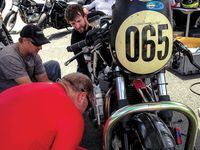I had been enjoying Sonoma Raceway's tricky turn four all day, but not this lap. It was oil that I hit, and I knew it before I even met the ground. The loss of traction was unmistakable, and next thing I knew I was watching the bike slide away from me. I willed my borrowed Triumph Thruxton racer not to tumble as it slid off the track, but sure enough it did. There was one graceful barrel roll before it landed heavily on the tank and instruments and came to a rest.
After making sure I wasn’t leaking any fluids myself, I had a rotten realization. This was my warm-up race! The actual Thruxton Challenge I had driven 400 miles to compete in was taking place in about 25 minutes, and the bike was a functionless heap. I rode the crash truck back to the pits, glaring at the transgressing machine sitting next to me and slouching in self-pity. I gave up on making the race.
The boys from British Customs looked over the bike back in the pits and politely said they didn’t regret letting me race their bike. I took the bellypan off, dumped out the gravel, and guiltily began picking debris from the dash. Then the mood changed. The swarm of Thruxton Cup competitors surrounding our pit transformed into a bustle of activity—hands on hips and furrowed brows changed to rags cleaning tires and pliers bending levers straight. These were my potential rivals, mind you, tucking their leathers back and trying furiously to fix my bike.
Racers help each other because they’re all afflicted with the same addiction. That needle in the arm that is dragging a knee around a racetrack becomes a unifying factor and transcends societal hierarchy. Doctors, plumbers, lawyers, farmers, engineers—it doesn’t matter. Some sleep in $150,000 luxury motorhomes, others just recline the seat in their pickup truck, but they’re all there for the same reason.
And they all had their sleeves rolled up to help me, for no other reason than they know how it feels to miss a race. I looked up from picking grass out of the number plate bracket to see the Thruxton had a new clip-on, footpeg, and controls on the left side. My competitors slapped me on the back as they pulled on their leathers and helmets, and that was it. Everything was clean and the bike was ready to go. After a cautious warm-up lap trying to make sure everything worked properly, I gridded up and took the green flag.
If you’ve ever competed in amateur racing, you might have experienced—or witnessed—this very thing. It’s not uncommon. Full engine swaps will take place, or sometimes an entire motorcycle is given up just to get a friend—even a rival—back on the track. Racers share food because they’ve raced hungry, offer shade because they’ve baked in leathers, and hand over parts as though it’s their own bike that needs to be fixed. It’s as if their own happiness depends on it—because it does. It is a community in the truest sense.
On the last lap, in the heat of battle, I passed one of my Thruxton Cup rivals and beat him to the checkered flag. After a huge post-race smile and handshake from him, I realized he was the first one to scurry over to our pit with a box of spare parts and a can-do attitude. There was no bitterness that he was beaten. He was happy to have another person on the track who knows how much fun motorcycles can be. Unlike most addicts, all he wanted to do was share his fix.











/cloudfront-us-east-1.images.arcpublishing.com/octane/QCZEPHQAMRHZPLHTDJBIJVWL3M.jpg)
/cloudfront-us-east-1.images.arcpublishing.com/octane/HXOUJXQWA5HBHGRO3EMJIGFMVI.jpg)

/cloudfront-us-east-1.images.arcpublishing.com/octane/3TIWWRV4JBBOLDVGRYECVVTA7Y.jpg)
/cloudfront-us-east-1.images.arcpublishing.com/octane/KIX5O23D5NAIBGFXBN3327DKZU.jpg)
/cloudfront-us-east-1.images.arcpublishing.com/octane/7GJYDUIPXRGMTMQKN6ONYOLBOU.jpg)
/cloudfront-us-east-1.images.arcpublishing.com/octane/MUQLOVLL2ZDGFH25ILABNBXKTI.jpg)
/cloudfront-us-east-1.images.arcpublishing.com/octane/TNOU5DNE2BC57MFPMGN2EIDXAM.jpg)
/cloudfront-us-east-1.images.arcpublishing.com/octane/GTCXACQGJ5HAPDTGWUQKDEH44E.jpg)
/cloudfront-us-east-1.images.arcpublishing.com/octane/S35YGSEMEZB4BLTDJTSZPF4GLA.jpg)
/cloudfront-us-east-1.images.arcpublishing.com/octane/5UOT6HPX2JFMRJAX6EH45AR4MQ.jpg)
/cloudfront-us-east-1.images.arcpublishing.com/octane/OKWOJWAKP5EP3OACCRRWPCIX2Q.jpg)
/cloudfront-us-east-1.images.arcpublishing.com/octane/2WF3SCE3NFBQXLDNJM7KMXA45E.jpg)
/cloudfront-us-east-1.images.arcpublishing.com/octane/G4MG6OUCJNBSHIS2MVVOTPX65E.jpg)
/cloudfront-us-east-1.images.arcpublishing.com/octane/IIGGWFOTOJGB7DB6DGBXCCMTDY.jpg)
/cloudfront-us-east-1.images.arcpublishing.com/octane/QSTCM6AVEZA5JJBUXNIQ3DSOF4.jpg)
/cloudfront-us-east-1.images.arcpublishing.com/octane/U4I7G625B5DMLF2DVIJDFZVV6M.jpg)
/cloudfront-us-east-1.images.arcpublishing.com/octane/B6XD6LS6IVCQPIU6HXDJSM3FHY.jpg)
/cloudfront-us-east-1.images.arcpublishing.com/octane/ICL63FEDDRDTTMINYICCEYGMDA.jpg)
/cloudfront-us-east-1.images.arcpublishing.com/octane/FCGZHQXRBZFLBAPC5SDIQLVF4I.jpg)
/cloudfront-us-east-1.images.arcpublishing.com/octane/WNOB6LDOIFFHJKPSVIWDYUGOPM.jpg)

/cloudfront-us-east-1.images.arcpublishing.com/octane/X33NU3E525ECRHXLNUJN2FTRKI.jpg)
/cloudfront-us-east-1.images.arcpublishing.com/octane/6KKT5NNL2JAVBOXMZYS5ZO76YA.jpg)